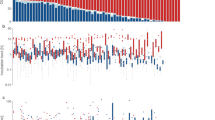Synopsis
Physiological studies revealed that agitation (simulated fanning) of the brood results in increased oxygen consumption, increased developmental rate and general promotion of brood success. It was also found that the more intense the agitation (excursions per minute) the greater the metabolic rate is enhanced. Embryos exposed to continual agitation hatched approximately twenty hours in advance of non-agitated eggs. Temporal studies of fanning activity inEtroplus maculatus showed significant differences between pairs breeding in colonial situations as compared to those breeding in isolation. Parental behaviors were recorded throughout egg care until hatching. Two types of ventilatory behaviors were described: active fanning and passive fanning. Pairs breeding in isolation invested more time in long passive bouts and less time in short active bouts. Conversely, colonial parents fanned predominately with short active bouts and displayed no prolonged passive fanning. Surprisingly, no differences were apparent in either reproductive success or hatching time between isolated and colonial pairs in this study. Orange chromides readily nested in two extremely different situations. They also displayed significantly different fanning regimes, behavioral time budgets and transitions of behavior; yet they were equally successful. Parental orange chromides can modulate their ventilatory activities in response to the contingencies of their nesting situation which ultimately allows them maximization of reproductive success.
Similar content being viewed by others
References cited
Barlow, G.W. 1964. Ethology of the Asian teleostBadis badis. V. Dynamics of fanning and other parental activities, with comments on the behavior of the larvae and postlarvae. Z. Tierpsychol. 21: 99–123.
Blumer, L.S. 1979. Male parental care in the bony fishes. Quart. Rev. Biol. 54: 149–161.
Daykin, P.N. 1965. Application of mass transfer theory to the problem of respiration in fish eggs. J. Fish. Res. Board Can. 22: 159–171.
Fishelson, L. 1966. Cichlidae of the genusTilapia in Israel. Bull. Fish. Cult. Isr. 18: 67–80.
Jones, A.J. 1972. The early development of substrate-brooding cichlids (Teleostei: Cichlidae) with a discussion of a new system of staging. J. Morphol. 136: 255–272.
Keenleyside, M.H.A. 1979. Diversity and adaptation in fish behavior. Springer-Verlag, New York. 208 pp.
Mertz, J.C. & G.W. Barlow. 1966. On the reproductive behavior ofJordanella floridae (Pisces: Cyprinodontidae) with special reference to the quantitative analysis of parental fanning. Z. Tierpsychol. 23: 537–554.
Oppenheimer, J.R. & G.W. Barlow. 1968. Dynamics of parental behavior in the black-chinned mouthbreeder,Tilapia melanotheron (Pisces: Cichlidae). Z. Tierpsychol. 25: 889–914.
Orians, G.H. 1961. The ecology of blackbird (Agelaius) social organization. Ecol. Monographs 31: 285–312.
Rechten, C. 1980. Brood relief behavior of the cichlid fishEtroplus maculatus. Z. Tierpsychol. 52: 77–102.
Samarakoon, J.I. 1981. Parental behavior and ecology of the Aslan cichlidsEtroplus maculatus andEtroplus suratensis. Ph.D. Thesis, Illinois State University, Normal. 331 pp.
Sargent, R.C. & J.B. Gebler. 1980. Effects of nest concealment on hatching success, reproductive success, and paternal behavior of the threespine stickleback,Gasterosteus aculeatus. Behav. Ecol. Sociobiol. 7: 137–142.
Shaw, E.S. & L.R. Aronson. 1954. Oral incubation inTilapia macrocephala. Bull. Amer Mus. Nat. Hist. 103: 375–416.
Ward, J.A., R.H. Miller, R. Chaudhari & S. Skinner. 1976. Behavioral item reduction program for precedes/follows contingency table format for Datamyte recorded behavioral events. Trans III. State Acad. Sci. 69: 265–280.
Ward, J.A. & J.I. Samarakoon. 1981. Reproductive tactics of the Asian cichlids of the genusEtroplus in Sri Lanka. Env. Biol. Fish. 6: 95–103.
Wyman, R.L. & J.A. Ward. 1973. The development of behavior in the cichlid fishEtroplus maculatus (Bloch). Z. Tierpsychol. 33: 461–491.
Author information
Authors and Affiliations
Rights and permissions
About this article
Cite this article
Zoran, M.J., Ward, J.A. Parental egg care behavior and fanning activity for the orange chromide,Etroplus maculatus . Environ Biol Fish 8, 301–310 (1983). https://doi.org/10.1007/BF00001096
Received:
Accepted:
Issue Date:
DOI: https://doi.org/10.1007/BF00001096




